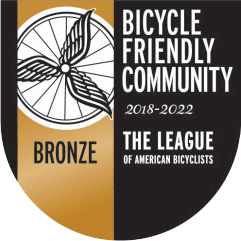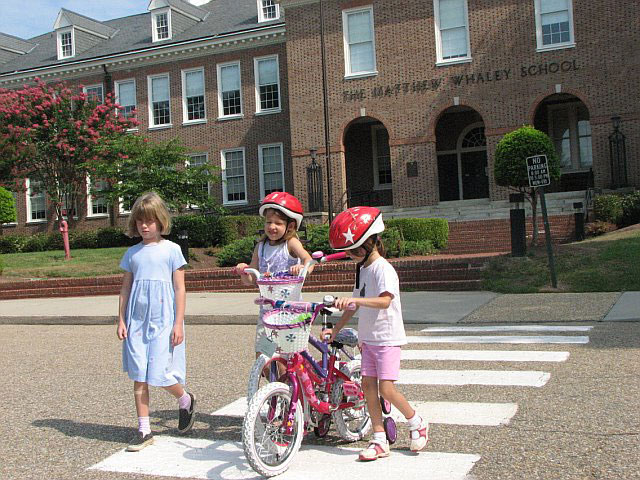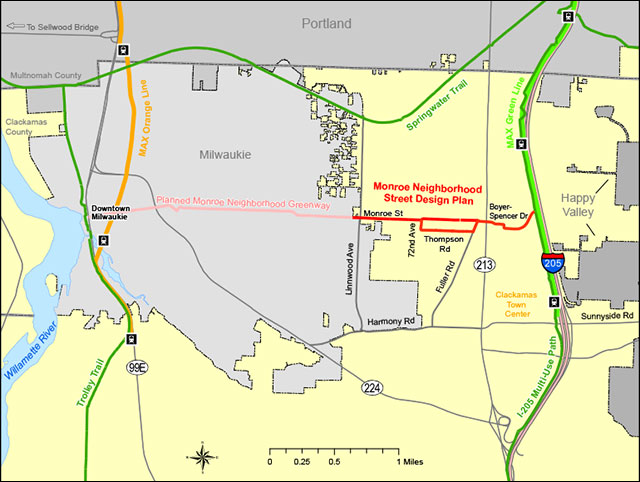Road Classifications
alley: an alley provides access to the rear of properties and may be public or private. Alleys should intersect local roads or connectors. Alleys are not for through traffic.
city streets: similar to County roads, except under the jurisdiction of a city.
collector: a road that is a principal carrier within neighborhoods or single land use areas. Collectors link neighborhoods with major activity centers, other neighborhoods and arterials and are generally not for through traffic. They carry low-to-moderate volumes of traffic at low-to-moderate speeds. New collectors should intersect minor arterials rather than major arterials. Examples:
Hill Road, Aldercrest Road, Howard's Mill Road
connector: a road that collects traffic from and distributes traffic to local streets within neighborhoods or industrial districts. Connectors are usually longer than local streets and carry low volumes of traffic at low speeds. Connectors primarily serve access and local circulation functions, and are not for through traffic. Traffic calming measures may be appropriate. A connector should connect to a collector or minor arterial. Examples: Oregon Trail Dr.; Sieben Creek Dr.
county roads: Public roads for which the Clackamas County Board of Commissioners has accepted maintenance responsibility.
functional classification: categorizing roads based on the type of service provided: freeway/expressway, major arterial, minor arterial, collector, connector or local road.
freeway/expressway: a highway that serves inter-regional and intra-regional trips, and carries heavy volumes of traffic at high speeds. Examples: I-205; the Milwaukie Expressway (Oregon Highway 224)
interstate highways: multi-lane federal highway that provides connections to major cities, regions of the state and other states. Interstate highways are major freight routes. Maintenance responsibilities belong to the Oregon Department of Transportation. There are two interstate highways in Clackamas County: I-5 and I-205.
jurisdictional classifications: a classification of roads based on ownership of the road.
local: a road designed to provide access to abutting property and to connect to higher order roads. New local roads should intersect connectors, collectors or, if necessary, minor arterials. Traffic calming measures may be appropriate. Local roads are inappropriate for through traffic.
major arterial: a road that primarily carries local and through traffic to and from destinations outside local communities; connects cities and rural centers, and carries moderate-to-heavy volumes of traffic at moderate-to-high speeds. Examples: Sunnyside Road, Boones Ferry Road
minor arterial: a road that primarily connects collectors to higher order roadways, and carries moderate volumes of traffic at moderate speeds. Examples: Oatfield Road, Beavercreek Road, Borland Road
private roads: roads owned by a private property owner. Public access and use is by permission of the property owner.
public roads: roads owned by the county or on a county easement that are not maintained by the county; maintenance responsibility lies with abutting property owners.
state highways: state-owned roads that provide the primary connections to larger urban areas, ports and major recreational areas that are not directly served by interstate highways. Maintenance responsibilities belong to the Oregon Department of Transportation. Examples in Clackamas County: Oregon Highway 213, Oregon Highway 224, Oregon Highway 99E
Design/Engineering Terms
capacity: the maximum rate at which persons or vehicles can be reasonably expected to traverse a point or uniform segment of a lane or roadway during a specified time period under prevailing roadway, traffic and control conditions; usually referred to as vehicles per hour or persons per hour. This is the standard used to determine when additional lanes need to be added.
centerline miles: miles of roadway measured without regard to the number of lanes or functional classification of the road.
design standards: those conditions that should be met when a new road is constructed or when a deficient section is improved. Standards include all relevant geometric and structural features required to provide a desired level of service over the life of the project — generally 20 years beyond completion.
frontage road: a road that parallels the interstate to relieve traffic congestion caused by local trips.
interchange: a highway intersection allowing traffic to move freely from one road to another without crossing another lane of traffic.
level of service: a qualitative measure of traffic conditions generally described as speed and travel time, freedom to maneuver, traffic interruptions, comfort and convenience, and safety.
overpass: an elevated roadway that crosses over another thoroughfare.
right-of-way: the property for infrastructure including travel lanes, parking, bikeways, sidewalks, utilities, shoulders, etc.
Funding Terms
distribution formula: refers to the statutorily defined formula for allocating state motor fuel tax revenues to specific programs and entities.
system development charges: Fees collected when a permit for any new development is issued. These fees finance transportation capacity improvements, including stop lights, traffic signals, new lanes and new roads. These funds may not be used for maintenance.
Tax Increment Financing (TIF): Revenues generated by new growth within specified areas designated are urban renewal districts; used to construct capital improvements that solve transportation problems within the same areas.
Transportation Equity Act for the 21st Century (TEA-21): The 1998 federal transportation funding legislation that provided an emphasis on protecting the environment and reducing congestion, relying on the most efficient transportation mode, and providing increased flexibility to state and local governments on the use of federal funds.
Environmental Terms
Endangered Species Act (ESA): a 1973 act of Congress that seeks to protect various species of fish, wildlife and plants that have the potential of being rendered extinct as a consequence of growth without adequate conservation. The ESA is concerned with "species that are of aesthetic, ecological, educational, historical, and scientific value to this nation and its people." Fourteen varieties of salmon and steelhead have been listed in this region. Once a species is listed, no one may "take" it (harass, harm, pursue, hunt, shoot, wound, kill, trap, capture, or collect, or attempt to engage in such conduct) without a permit. Federal agencies are required to ensure that any federal action, such as constructing a highway, is not likely to jeopardize the continued existence of a listed species or adversely modify critical habitat. Road projects that traverse critical habitat must be reviewed for their impacts on listed species.
in-water work period: a window of time in which construction is allowed within the banks of a stream or river, as specified by the ESA, when the water level is at its lowest and it is the least disruptive time for fish. Example: July 1– Sept. 30 is the in-water work period for Mt. Scott Creek.
riparian area: the banks of a river or stream.
Wetland: a lowland area, such as a marsh or swamp, saturated with moisture. A natural wildlife habitat.
Maintenance Terms
chip seal: a sprayed-on application of an asphaltic emulsion, with a thin layer of aggregate spread over an existing surface. The emulsion improves or restores the waterproof condition of the old pavement surface and arrests any scuffing or raveling. The addition of a cover of aggregate over the sprayed-on emulsion restores and improves skid resistance.
cold mix: see Pugg Mix below.
contract overlays: work completed by private contractors when pavement rehabilitation is beyond routine maintenance. Rehabilitation activities include hot and cold recycling, structural overlays and reconstruction. Rehabilitation is intended to salvage, strengthen and modernize badly deteriorated pavement. Contract overlays and rehabilitation should provide for an additional 10–20 years of serviceability at reduced maintenance costs.
maintenance overlays: a process of applying hot asphaltic concrete to an average depth of 1 1/2 inches to create a new, smoother driving surface.
pavement structure: The combination of subbase, base, base course and surface course placed on a subgrade to support the traffic load and distribute it to the road bed.
pugg mix: Sometimes called cold mix, emulsified asphalt is mixed with aggregate at a site near the road to be resurfaced. Open-graded cold mix cures more slowly than hot asphaltic concrete and generally requires a load limit for a short period. A chip seal is often placed as a wearing surface. Where there may be turning movements or other special needs, the softer open-graded cold mix may be replaced with hot mix in critical sections.
reconstruction: Complete road reconstruction (i.e., remove and replace existing pavement) on essentially the present alignment for distance of at least 0.3 miles.
resurfacing, including shoulder improvements: adding an overlay in excess of 3/4 inch, plus appropriate improvements to shoulders such as adding material to bring them up to grade, widening or reconstructing shoulders.
routine maintenance: Includes all operating and maintenance activities that are conducted on a frequent and ongoing basis (e.g., cleaning and shaping drainage facilities, operating and replacing traffic control devices, maintaining roadside facilities, street sweeping, snow and ice control, grading unpaved roads, emergency pothole patching, and pavement joint sealing and skin patching).
Bridge Programs
bridge improvement: Major rehabilitation and strengthening and/or replacement of existing structures undertaken independently of improvements to the roadway.
bridge rehabilitation: Involves major structural modifications to an existing bridge including widening, substructure repair, superstructure strengthening, deck replacement or rehabilitation, and rail improvement.
 Translate
Translate








